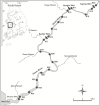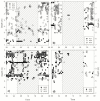Movement Patterns and Diel Activity of Anguilla japonica in the Middle Part of a Large River in South Korea
- PMID: 33348875
- PMCID: PMC7766186
- DOI: 10.3390/ani10122424
Movement Patterns and Diel Activity of Anguilla japonica in the Middle Part of a Large River in South Korea
Abstract
To investigate movement patterns and diel activities of Anguilla japonica in the freshwater ecosystem, we applied acoustic telemetry on A. japonica in the Geum River, a large river in South Korea. The acoustic tags were attached on 19 individuals of A. japonica (12 with a depth sensor) in May and October 2015 and tracked at approximately 100-km sections from an estuary barrage by 20 automatic listening stations. Only four individuals showed longitudinal movement (mean, 5.2 km), and others were detected by the receivers at release sites; therefore, A. japonica showed high site fidelity. We did not identify seaward migration during the study period (May to November). Conversely, A. japonica showed active diel movement. The number of detections (p = 0.002) and movement distance (p = 0.004) were higher at night-time (18:00-06:00). As most individuals were actively moving at nighttime, we confirmed that A. japonica is nocturnal, although few individuals also showed daytime movement. Although the population and habitats of A. japonica have been decreasing simultaneously, the East-Asian countries are still severely exploiting rivers and streams to use water resources, and result in habitat simplification generated. Therefore, these results contribute to effective A. japonica management regarding habitat and population conservation and restoration.
Keywords: acoustic telemetry; diel movement; nocturnal species; vertical movement.
Conflict of interest statement
The authors declare no conflict of interest.
Figures






Similar articles
-
Migration, residency and habitat utilisation by wild and cultured Japanese eels (Anguilla japonica) in a shallow brackish lagoon and inflowing rivers using acoustic telemetry.J Fish Biol. 2021 Feb;98(2):507-525. doi: 10.1111/jfb.14595. Epub 2020 Nov 20. J Fish Biol. 2021. PMID: 33070333
-
Unravelling the life-history patterns and habitat preferences of the Japanese eel (Anguilla japonica) in the Pearl River, China.J Fish Biol. 2024 Feb;104(2):387-398. doi: 10.1111/jfb.15303. Epub 2023 Jan 30. J Fish Biol. 2024. PMID: 36600527
-
River and estuary movements of yellow-stage American eels Anguilla rostrata, using a hydrophone array.J Fish Biol. 2010 Apr;76(6):1294-311. doi: 10.1111/j.1095-8649.2010.02561.x. J Fish Biol. 2010. PMID: 20537015
-
Contrasting riverine distribution and habitat use of the Japanese eel, Anguilla japonica, and the giant mottled eel, Anguilla marmorata, in a sympatric river.J Fish Biol. 2022 Dec;101(6):1617-1622. doi: 10.1111/jfb.15224. Epub 2022 Oct 17. J Fish Biol. 2022. PMID: 36161466
-
Diel vertical migration behaviour of the Northern krill (Meganyctiphanes norvegica Sars).Adv Mar Biol. 2010;57:255-75. doi: 10.1016/B978-0-12-381308-4.00009-1. Adv Mar Biol. 2010. PMID: 20955895 Review.
References
-
- Tesch F.-W. Homing of eels (Anguilla anguilla) in the southern North Sea. Mar. Biol. 1967;1:2–9. doi: 10.1007/BF00346688. - DOI
-
- Tesch F.W. The Eel. Blackwell Publishing; Oxford, UK: 2003.
-
- Fishbase. [(accessed on 1 November 2020)]; Available online: http://www.fishbase.org.
-
- Ishikawa S., Aoyama J., Tsukamoto K., Nishida M. Population structure of the Japanese eel Anguilla japonica as examined by mitochondrial DNA sequencing. Fish. Sci. 2001;67:246–253. doi: 10.1046/j.1444-2906.2001.00227.x. - DOI
Grants and funding
LinkOut - more resources
Full Text Sources
Research Materials

